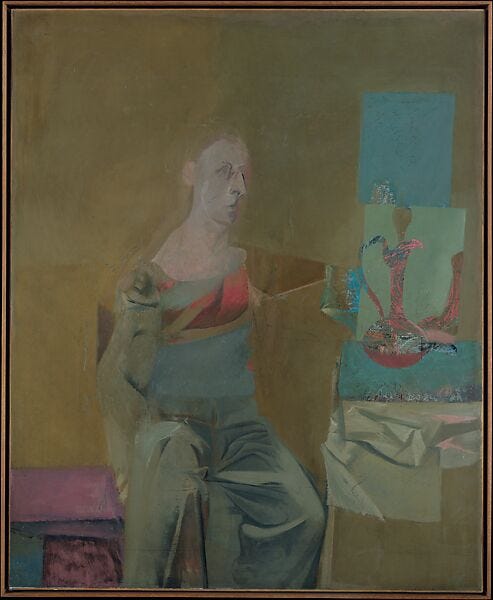Art in America 1945–1970 (2)
An Asynchronous Studio Book Club reading of Art in America 1945-1970: Writings from the Age of Abstract Expressionism, Pop Art, and Minimalism, edited by Jed Perl.

James Agee
Perl’s paragraph-length biography of Agee sticks to business, noting the author’s A Death in the Family, his involvement in Let Us Now Praise Famous Men, and becoming a noted film critic. He skips over the three marriages and his script for an unrealized Charlie Chaplin film in which the Tramp survives a nuclear holocaust. This is not a criticism of Perl, but an indicator that some additional poking around on the internet concerning the anthologized authors rather pays off.
Agee’s treatment of Helen Leavitt is regarded as such a masterpiece of photographic criticism that Perl was moved to include it despite its reference, by number, to plates of her work that the reader is forced to imagine or track down. His earlier remarks, concerning the veracity of photography (“it is in fact hard to get the camera to tell to tell the truth,” he wrote), could have stood on their own. But then we would have missed lines like this: “But subtly, ineluctably, the quality of citizenship in this world where all are kings and queens begins to shift, and almost invariably, to decline and to disintegrate.” I hope one day to move a friend with this kind of literary gift to write an encomium of my art at such length. My one misgiving is that the more he repeated the term lyrical, the less sure I knew what he meant.
Charles Burchfield
We already spent time with Burchfield (one, two) but it was gratifying to spend a little more. The Burchfield diaries are voluminous and Perl’s choice of some notes from 1948-50 is as apt as any. A real artist ought to stand in awe of his gift: “In the night, it suddenly came to me that a picture of countless butterflies dancing in hot sunlight would be worthwhile.”
Robert M. Coates
“Mondrian, Kleenex, and You” from the October 15, 1949 issue of The New Yorker is available to subscribers. “[O]ne of the oddest paradoxes of our time,” he wrote, “ is that the very people who denounce modern art as purposelessness, meaningless, and unattractive, or even in some way immoral, are at the same moment, without realizing it, allowing their tastes to be changed by it and their buying habits influenced by it.” I still run across educated people who think modern art is a scam, find Pollock incomprehensible, and so on. The incomprehension appears permanent.
Willem de Kooning
Somewhat like Rothko, de Kooning had woolly things to say about painting. In the Renaissance:
The drawing started to tremble because it wanted to go places. The artist was too perplexed to be sure of himself. How do we know, he thought, that everything is really not still, and only starts moving when we begin to look at it? Acutally there was no “subject matter.” What we call subject-matter now, was then painting itself. Subject matter came later on when parts of those works were taken out arbitrarily, when a man for no reason is sitting, standing or lying down.
Unlike Rothko, de Kooning didn’t aspire to be an author of treatises. The two pieces included by Perl are the whole of his written output. That means that they’re the source of nearly every quotable de Kooning quip: “from the point of view of the universe, [man’s attempts at order] must be very grotesque,” “flesh is the reason that oil paint was invented,” et cetera. The statements don’t make us long for a de Kooning book, but for an opportunity to converse with the man.
Edwin Denby
That impression heightens with Edwin Denby’s recollection, solicited by Pat Pasloff, of what it was like to hang out with de Kooning and photographer Rudy Burckhardt in the 1930s. They would traipse from cafeteria to cafeteria all night, drinking coffee and talking. Denby said of de Kooning, “Self protection bored him.”
In the talk then about painting, no doctrine of style was settled at Bill’s. He belligerently brought out the mysterious paradoxes left over. In any style he kept watching the action of the visual paradoxes of painting—the opposition of interchangeable centers, or a volume continued as a space, a value balancing a color. He seemed to consider in them a craft by which the picture seen as an image unpredictably came loose, moved forward and spread. On the other hand, his working idea at the time was to master the plainest problems of painting. I often heard him say that he was beating his brains out about connecting a figure and a background. The basic connection he meant seemed to me a motion from inside them that they interchanged and that continued throughout. He insisted on it during those years stroke by stroke and gained a virtuoso’s eye and hand. But he wanted everything in the picture out of equilibrium except spontaneously all of it. That to him was one objective professional standard. That was form in the way the standard masterpieces had form—a miraculous force and weight of presence moving from all over the canvas at once.
Thus temporarily concludes our time with Art in America 1945–1970. This Friday we discuss the first quarter of Tolstoy’s What Is Art? I have an old print copy of the Aylmer Maude translation. There are digital copies all over the internet, including Project Gutenberg and Archive.org. Jump in.
Content at DMJ is free but paid subscribers keep it coming. They also have access to Dissident Muse Salons, print shop discounts, and Friend on the Road consultations. Please consider becoming one yourself and thank you for reading.
Our next title in the Asynchronous Studio Book Club is What Is Art? by Leo Tolstoy. For more information, see the ASBC homepage.
The current exhibition in the Dissident Museum is David Curcio: The Point of the Needle.



